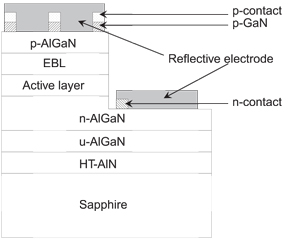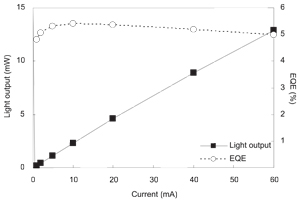- News
12 December 2011
Reflections on DUV light extraction
Researchers based in Nagoya, Japan have been using reflective contacts to improve light extraction from deep ultraviolet light-emitting diodes (DUV-LEDs) [Tetsuhiko Inazu et al, Jpn. J. Appl. Phys., vol50, p122101, 2011]. Power increases of up to 1.55x over devices without reflectors were observed.
DUV-LED devices are being developed for sterilization and water purification applications that need light with wavelengths less than 300nm. Other possible applications include UV curing of thin coats, printing, phototherapy, and photocatalysis.
Presently, DUV light is produced by mercury lamps that are fragile and contain poisonous material. For semiconductor devices to be a viable alternative, the present external quantum efficiencies (EQEs) of a few percent for aluminum gallium nitride (AlGaN) DUV-LEDs need to be increased. One way to boost EQE is to increase photon extraction from the device. Reflective contacts can decrease light absorption in the p-semiconductor layers and n-contact. The p-semiconductor tends to be GaN in order to achieve reasonable hole densities for injection. However, the GaN energy bandgap is narrower than that of the AlGaN active region, meaning that it strongly absorbs DUV light.
 The researchers from UV Craftory Co Ltd and Meijo and Nagoya universities grew devices (Figure 1) on sapphire substrates using metal-organic chemical vapor deposition (MOCVD). The active light-emitting layer consisted of a single well of Al0.35Ga0.65N. The undoped buffer (u-AlGaN) and silicon-doped cladding (n-AlGaN) consisted of material with 60% Al, grown on high-temperature (HT)-deposited AlN. The magnesium-doped p-type layers were a 70%-Al electron-blocking layer (EBL), a 45%-Al cladding layer and a pure GaN contact layer. The 45%-Al AlGaN layer gave an ultraviolet cut-off of 280nm.
The researchers from UV Craftory Co Ltd and Meijo and Nagoya universities grew devices (Figure 1) on sapphire substrates using metal-organic chemical vapor deposition (MOCVD). The active light-emitting layer consisted of a single well of Al0.35Ga0.65N. The undoped buffer (u-AlGaN) and silicon-doped cladding (n-AlGaN) consisted of material with 60% Al, grown on high-temperature (HT)-deposited AlN. The magnesium-doped p-type layers were a 70%-Al electron-blocking layer (EBL), a 45%-Al cladding layer and a pure GaN contact layer. The 45%-Al AlGaN layer gave an ultraviolet cut-off of 280nm.
Figure 1: Schematic design of LED structure with reflective electrodes.
The mesa area was 0.16mm2 in a 0.64mm2 chip. The reflective p-electrode (Figure 2) was formed by etching down through the p-GaN to the p-AlGaN cladding using a nickel mask. This reduced the p-GaN area to 33%. Nickel-gold ohmic contacts were made on the remaining p-GaN. The p-AlGaN windows were made reflective by electron-beam evaporating onto them 100nm aluminum, 100nm titanium, and 200nm gold. Finally, titanium-gold bond pads were deposited.
 Figure 2: Dependences of EQE and output power on forward current for 288nm LED.
Figure 2: Dependences of EQE and output power on forward current for 288nm LED.
The n-contact consisted of a 20μm-wide ohmic contact adjacent to the mesa side-wall and Al/Ti/Au reflector covering the rest of the exposed n-cladding surface. The n-reflector covered 0.35mm2 and the contact 0.05mm2.
Comparison devices without reflectors were also produced. The chips were flipped onto aluminum nitride submounts and packaged in TO-5 metal cans/headers.
The observed improvements in light extraction were broken down by making devices with just p- or n-reflectors. The light output was increased 1.16x with just an n-reflector and 1.27x with just a p-reflector. With both n- and p-reflectors, the power was increased 1.55x over a device without any reflectors.
The electroluminescence spectrum at 20mA dc shows a single peak at 295nm without parasitic satellites. One effect of the reflectors was to reduce the contact area, particularly for the p-type side of the device, resulting in a higher forward voltage (+0.45V).
Endurance tests were also carried out with the light output of the device with reflective contacts remaining over 80% of its original value at 20mA dc after 1000 hours. The forward voltage did not fluctuate over this period. The devices without reflectors degraded in performance more slowly.
The researchers are not clear why the performance of the devices with reflectors should decay more quickly, although they suggest that a decrease in reflectance from Al-Ti/Au alloy formation over time may be responsible. This alloying may also be encouraged by the higher forward voltage that leads to more self-heating at the junction.
The reflective device extrapolated lifetimes for 70% and 50% light output power operation at 20mA dc were 4000 hours and 10,000 hours, respectively.
The researchers applied their reflectors also to 288nm LEDs grown on higher-quality AlGaN templates. A peak EQE of 5.4% was achieved at 10mA (Figure 2). The same research group achieved 5.1% EQE with 280nm LEDs without reflectors earlier this year [Cyril Pernot et al, physica status solidi (a), vol208, p1594, 2011]. With DC operation, the light output from the 288nm LEDs with reflectors was 4.6mW at 20mA and 13mW at 60mA.
The same team has also developed moth-eye technology that they hope could boost performance by up to 50% [Deep UV LED efficiency reaches 3%].
Deep UV LEDs Sapphire substrates AlGaN
The author Mike Cooke is a freelance technology journalist who has worked in the semiconductor and advanced technology sectors since 1997.
